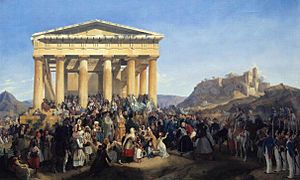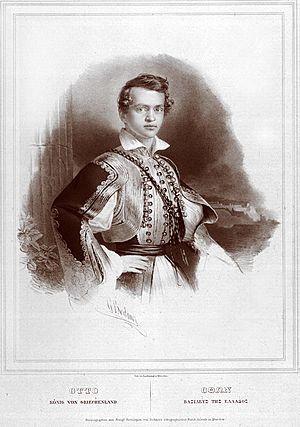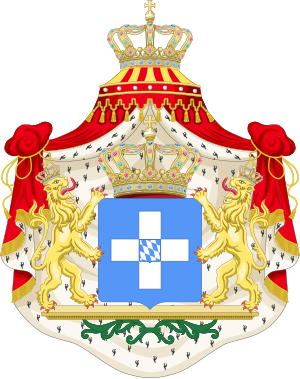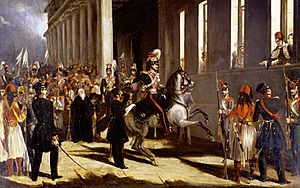Otto of Greece facts for kids
Quick facts for kids Otto |
|
|---|---|
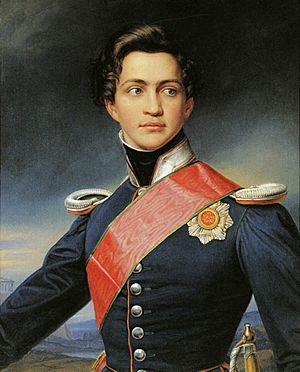
Portrait by Friedrich Dürck, 1833
|
|
| King of Greece | |
| Reign | 27 May 1832 – 23 October 1862 |
| Successor | George I (as King of the Hellenes) |
| Regent | Josef Ludwig von Armansperg (1832–1835) |
| Prime Ministers |
See list
Spyridon Trikoupis
Alexandros Mavrokordatos Ioannis Kolettis Josef Ludwig von Armansperg Ignaz von Rudhart Andreas Metaxas Konstantinos Kanaris Kitsos Tzavelas Georgios Kountouriotis Athanasios Miaoulis Gennaios Kolokotronis |
| Born | Otto Friedrich Ludwig von Bayern 1 June 1815 Salzburg, Austrian Empire |
| Died | 26 July 1867 (aged 52) Bamberg, Kingdom of Bavaria |
| Burial | Theatinerkirche, Munich |
| Spouse |
Amalia of Oldenburg
(m. 1836) |
| House | Wittelsbach |
| Father | Ludwig I of Bavaria |
| Mother | Therese of Saxe-Hildburghausen |
| Religion | Roman Catholicism |
| Styles of Otto I of Greece |
|
|---|---|
| Reference style | His Majesty |
| Spoken style | Your Majesty |
Otto (Greek: Όθων, romanized: Óthon; German: Otto Friedrich Ludwig von Bayern; 1 June 1815 – 26 July 1867) was a Bavarian prince who became the first King of Greece. He ruled from May 27, 1832, until he was removed from power on October 23, 1862.
Otto was the second son of King Ludwig I of Bavaria. He became king of Greece when he was just 17 years old. At first, a group of three Bavarian officials, called a regency council, helped him rule. When Otto became an adult, he took over full control. He ruled as an absolute monarch, meaning he had all the power.
However, the people of Greece soon wanted a constitution, which is a set of rules for how the country should be governed. In 1843, after a peaceful uprising, Otto agreed to give Greece a constitution.
During his time as king, Otto struggled with Greece's money problems. He also had to deal with other powerful European countries like Britain, France, and Russia. These countries had helped Greece become independent. Otto needed their support to stay in power. He tried to balance their interests, but his standing suffered when the British navy blocked Greek ports in 1850 and 1854. This happened to stop Greece from attacking the Ottoman Empire during the Crimean War. In 1862, while Otto was away, he was removed from power. He died in his home country, Bavaria, in 1867.
Contents
Becoming King of Greece
Otto was born Prince Otto Friedrich Ludwig of Bavaria in Salzburg. At that time, Salzburg was briefly part of the Kingdom of Bavaria. His father, Ludwig I of Bavaria, was a big supporter of Greece. He gave a lot of money to help Greece during its War of Independence.
After the war, three major European powers (Britain, France, and Russia) decided that Greece should be an independent kingdom. They looked for a prince to be king. Many people were considered. Eventually, they chose Prince Leopold of Saxe-Coburg and Gotha. But Leopold decided not to take the crown because he worried about Greece's stability.
In 1832, the London Conference offered the crown to teenage Prince Otto. He was happy to accept. The Bavarian royal family, the House of Wittelsbach, was a good choice because they were not closely connected to any of the powerful European ruling families. This made them a neutral option that everyone could agree on. The Greek people were not asked, but Greece was in a very chaotic state at the time.
The Great Powers made Otto's father promise that Otto would not attack the Ottoman Empire. They also insisted that his title be "King of Greece," not "King of the Hellenes." This was because "King of the Hellenes" would suggest he ruled over all Greeks, including those still under Turkish rule.
Otto was not yet 18 when he arrived in Greece. He came with 3,500 Bavarian soldiers and three Bavarian advisors. He quickly became popular by wearing Greek national clothes and changing his name to "Othon." Thousands of people welcomed him in Nafplio. His arrival brought hope that the chaos in Greece would end and a new era would begin.
Early Years of Otto's Rule
Otto's time as king is often divided into three main periods:
- The years when a Regency Council ruled: 1832–1835
- The years when Otto ruled alone as an absolute monarch: 1835–1843
- The years when Greece had a constitution: 1843–1862
The Bavarian advisors formed a Regency Council. Count Josef Ludwig von Armansperg led this council. He was like the first Prime Minister of the new Greek government. The other members were Karl von Abel and Georg Ludwig von Maurer. They often disagreed with each other.
When Otto became an adult in 1835, he took full control. However, the British and the Rothschild bank, who gave loans to Greece, wanted strict financial rules. The Greek people soon felt they were taxed more heavily than under Ottoman rule. They felt they had simply traded one foreign rule for another, calling it "Bavarocracy" (rule by Bavarians).

The regency also did not respect local Greek customs very much. Otto was a Roman Catholic, and many religious Greeks saw him as a heretic. However, the 1843 Constitution stated that any future king would have to be Orthodox.
Some Greek heroes of the revolution, like generals Theodoros Kolokotronis and Yiannis Makriyiannis, did not like the Bavarian-led government. They were accused of working against the government and put in jail. They were later freed because of public pressure.
One important change during Otto's early rule was moving the capital of Greece from Nafplion to Athens. At that time, Athens was a small town with only about 4,000 to 5,000 people. It was chosen for its historical importance.
A modern city plan was created for Athens, and many public buildings were built. Some of these famous buildings include the University of Athens (1837), the Athens Polytechnic University (1837), the National Gardens of Athens (1840), the National Library of Greece (1842), and the Old Royal Palace (now the Greek Parliament Building, 1843). Schools and hospitals were also built across Greece.
In 1836–37, Otto visited Germany and married 17-year-old Duchess Amalia. Their wedding was in Oldenburg, Germany, on November 22, 1836. They never had children. Queen Amalia became unpopular because she tried to get involved in the government and kept her Lutheran faith.
When Otto returned from Germany, he fired Armansperg. He appointed another Bavarian, Ignaz von Rudhart, as chief minister. The idea of giving Greece a constitution was put off again. Otto tried to make Greeks happy by trying to expand Greece's borders, for example, by trying to get Crete in 1841. But this only caused problems with the Great Powers.
Challenges for King Otto
Throughout his reign, King Otto faced several ongoing problems:
- Greek political groups and their disagreements.
- Financial difficulties for the country.
- Disputes about the Church.
Greek political groups during Otto's time were often linked to the three Great Powers: Russia, Britain, and France. Each power had its own representatives in Athens who advised Greek politicians.
Greece was a poor country. Also, a few wealthy families owned most of the land. The Great Powers had promised Greece 60 million francs in loans. This meant they stayed involved in Greece's internal affairs. Otto often had to try and please one power or another to get money.
Otto tried to balance the power among these different political groups. He hoped this would make them less powerful. But his policies actually made the Great Powers' parties stronger. The Great Powers did not stop Otto from becoming more of an absolute ruler. This led to constant conflict between Otto's absolute rule and the power of his Greek subjects.
Otto also faced challenges with the Greek Church. His regents had tried to close down monasteries, which upset many religious leaders. As a Roman Catholic, Otto was seen with suspicion by many Orthodox Greeks.
In 1833, the regents declared that the Church of Greece was independent from the Patriarch of Constantinople. This was because the Patriarch was partly controlled by the Ottoman Empire. However, many faithful Greeks worried that having a Catholic king as head of the Greek Church would weaken the Orthodox Church.
Otto tried to show tolerance for other religions, like Catholicism and Judaism. This was seen by some as a sign that Greece was becoming a modern European country. In the end, control over the Church and education was given more to the "Russian Party," which supported Orthodoxy. However, the king still had a say in decisions by the Church leaders.
The 1843 Revolution
By 1843, many people were unhappy with King Otto. They demanded a Constitution. At first, Otto refused. But when his Bavarian troops were removed from Greece, a popular uprising began.
On September 3, 1843, soldiers led by Colonel Dimitris Kallergis and General Ioannis Makriyannis gathered in front of the Royal Palace in Athens. Many citizens joined them. The crowd refused to leave until the king agreed to their demands. They wanted Greeks to be part of his council, for him to call a National Assembly, and for him to personally thank the leaders of the uprising.
Since his German troops were gone, King Otto had no choice but to agree. He accepted the crowd's demands, even though his wife, Queen Amalia, disagreed. The square where this happened was renamed Constitution Square. This name remembers the events of September 1843. From then on, the king had Greeks in his council, and the different political parties (French, English, and Russian) competed for power.
Otto's reputation suffered in 1850 during the Pacifico incident. The British Foreign Secretary, Lord Palmerston, sent the British navy to block the port of Piraeus. This was to demand payment for an injustice done to a British citizen.
Later Years and Exile
Otto had a big dream called the Great Idea. This was the idea of bringing back the Byzantine Empire and uniting all Greeks. Because of this, he thought about joining the Crimean War in 1853 on Russia's side against Turkey, Britain, and France. This plan failed and led to Britain and France blocking the port of Piraeus again. Greece was forced to stay neutral in the war.
The king and queen never had children. This caused a problem for who would rule next. The 1844 constitution said that Otto's successor had to be Orthodox. His younger brothers, Luitpold and Adalbert, were Catholic and refused to convert. This made it difficult to decide who would be the next king.
In 1861, a student tried to attack Queen Amalia. This event actually made some Greeks feel more sympathy for the royal couple.
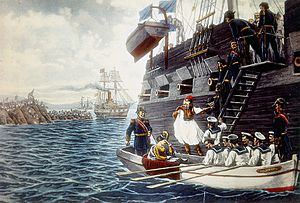
In 1862, while Otto was visiting the Peloponnese, a new uprising began. This time, a temporary government was set up. The ambassadors of the Great Powers told King Otto not to fight back. The king and queen left Greece on a British warship and returned to Bavaria. They took with them the Greek royal symbols they had brought from Bavaria in 1832. In 1863, the Greek National Assembly chose Prince William of Denmark, who was only 17, to be the new King of the Hellenes. He became King George I.
Some people believe that if Otto and Amalia had had a child, Otto might not have been overthrown.
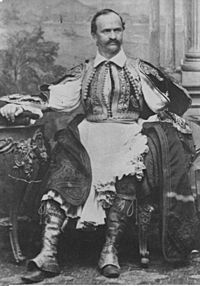
Otto died in Bamberg, Germany. He was buried in the Theatiner Church in Munich. Even in retirement, he still wore the traditional Greek uniform, which is now worn by the evzones (Presidential Guards). It is said that Otto's last words were, "Greece, my Greece, my beloved Greece."
Images for kids
-
Portrait of Otto by Joseph Karl Stieler
See also
 In Spanish: Otón I de Grecia para niños
In Spanish: Otón I de Grecia para niños
- Greek crown jewels


